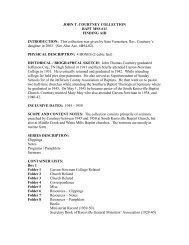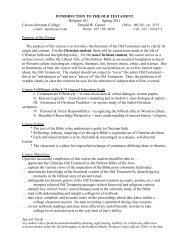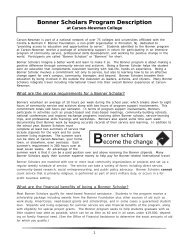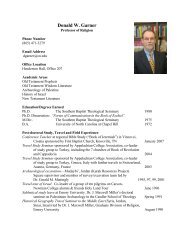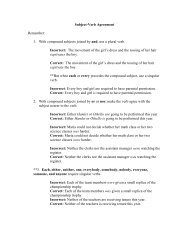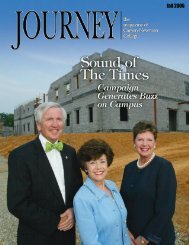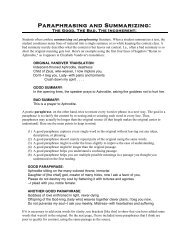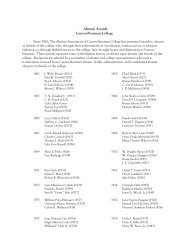PDF file
PDF file
PDF file
Create successful ePaper yourself
Turn your PDF publications into a flip-book with our unique Google optimized e-Paper software.
Linguistic Description<br />
STOPS (obstruents, plosives)<br />
bilabial: /b/ (voiced)<br />
/p/ (unvoiced)<br />
alveolar: /d/ (voiced)<br />
/t/ (unvoiced)<br />
velar: /g/ (voiced)<br />
/k/ (unvoiced)<br />
[Stops involve the complete closure of the air<br />
passage]<br />
AFFRICATIVES<br />
alveopalatal; /æ‡/ (voiced)<br />
/c‡/ (unvoiced)<br />
[Affricatives involve a stop plus a movement<br />
through a fricative position.]<br />
FRICATIVES (spirants)<br />
labiodental: /v/ (voiced)<br />
/f/ (unvoiced)<br />
dental: /D/ (voiced)<br />
/T/ (unvoiced)<br />
alveolar: /z/ (voiced)<br />
/s/ (unvoiced)<br />
alveopalatal: /z‡/ (voiced)<br />
/s‡/ (unvoiced)<br />
palatal: /C/ (unvoiced)<br />
velar: /x/ (unvoiced)<br />
glottal: /h/ (unvoiced)<br />
[Fricatives involve constriction of the air<br />
passage.]<br />
NASALS (nasal resonants)<br />
bilabial: /m/ (voiced)<br />
alveolar: /n/ (voiced)<br />
velar: /N/ (voiced)<br />
[Nasals involve complete closure of the oral<br />
passage with the nasal passage open.]<br />
LATERAL RESONANT (liquid)<br />
alveolar: /l/ (voiced)<br />
[Air is expelled through passages on the sides<br />
of the tongue.]<br />
MEDIAL RESONANTS (semi-vowels)<br />
alveopalatal: /r/ (voiced)<br />
palatal glide: /y/ (voiced)<br />
velar glide: /w/ (voiced)<br />
MIDDLE ENGLISH CONSONANT SOUNDS:<br />
26 in Middle English<br />
Mod. Eng. Lower<br />
Example Articulator<br />
bill<br />
pill<br />
dill<br />
till<br />
gill<br />
kill<br />
Jill<br />
Chill<br />
villa<br />
fill<br />
clothe<br />
cloth<br />
zeal<br />
sill<br />
rouge<br />
shall<br />
German ich<br />
German ach<br />
hill<br />
mill<br />
nill<br />
tang<br />
lower lip<br />
lower lip<br />
blade<br />
blade<br />
back of tongue<br />
back of tongue<br />
blade<br />
blade<br />
lower lip<br />
lower lip<br />
blade<br />
blade<br />
front of tongue<br />
front of tongue<br />
front of tongue<br />
front of tongue<br />
front of tongue<br />
back of tongue<br />
vocal cords<br />
lower lip<br />
blade<br />
back of tongue<br />
Upper<br />
Articulator<br />
upper lip<br />
upper lip<br />
alveolar ridge<br />
alveolar ridge<br />
velum<br />
velum<br />
far front of palate<br />
far front of palate<br />
upper teeth<br />
upper teeth<br />
upper teeth<br />
upper teeth<br />
alveolar ridge<br />
alveolar ridge<br />
far front of palate<br />
far front of palate<br />
palate<br />
velum<br />
vocal cords<br />
upper lip<br />
alveolar ridge<br />
velum<br />
lull blade alveolar ridge<br />
rill<br />
yet<br />
will<br />
front of tongue<br />
front of tongue<br />
back of tongue<br />
far front of palate<br />
palate<br />
velum
MIDDLE ENGLISH LONG VOWELS:<br />
Phonetic Symbol<br />
Graphemes<br />
Modern English<br />
Pronunciation Guide<br />
/a:/ a, aa father (with relaxed mouth)<br />
/e/ e, ee swear; eh<br />
/e/ (with a small tail curving on bottom) e, ee hay<br />
c<br />
/i/ i, y see<br />
/ç:/ o, oo law (Round lips and laugh like Sesame<br />
Street's "the Count")<br />
/o/ o, oo boat<br />
/u/ ou, ow boot<br />
MIDDLE ENGLISH SHORT VOWELS:<br />
Phonetic Symbol<br />
Graphemes<br />
Modern English<br />
Pronunciation Guide<br />
/a/ a hot<br />
/E/ e bet<br />
/I/ i, y bit<br />
/ç/ o law (with glide reduced)<br />
/U/ u, o full<br />
/´/ e but<br />
SOME ILLUSTRATIONS<br />
OF THE HISTORICAL SOUND CHANGE:<br />
ME (Middle English) Word Becomes . . . MnE (Modern English) Word<br />
/stç:n/ ‹ /ston/<br />
/spon´/ ‹ /spun/<br />
/hus´/ ‹ /haus/<br />
/met´/<br />
‹ /mit/<br />
c<br />
/fet´/ ‹ /fit/<br />
/wif´/ ‹ /wayf/<br />
Note: These handouts are adapted from materials created by Professor James Boren at the University of Oregon. Any mistakes in the<br />
material are a result of my own errors in transcription rather than a product of his original work.
Some Notes Relevant For Understanding the Great Vowel Shift<br />
1. EXCEPTIONS TO THE RULE THAT /u/ > /au/<br />
A. /u/ + a labial consonant (especially the voiced and unvoiced bilabial stops /b/ and /p/) does<br />
not diphthongize. It remains /u/ and in MnE sometimes shows the spelling by<br />
analogy with the spelling of those words which in ME moved from /o/ to /u/. For example,<br />
ME /u/ ‹ MnE /u/. Cf. , , , and .<br />
(Two MnE words, and , seem to conform to this generalization, but<br />
actually both of those words were borrowed from French after the Great Vowel Shift.)<br />
B. /u/ + /r/ + [consonant] remains /u/ and then lowers to /o/ much later--in some cases as late<br />
as the eighteenth century. For example, in ME , , and are<br />
pronounced with /u/. (In some ME words, /u/ had already shortened to /U/ before the GVS.<br />
Examples of this early shortening include these words: , , ,<br />
, and .) The best advice here is memorize, but don't analyze.<br />
C. MnE and are probably Northern forms which did not go through the<br />
vowel shift common to more southern dialects of ME. In other words, these words in MnE<br />
are pronounced as they were in ME.<br />
2. LENGTHENING OF OE SHORT VOWELS<br />
A. In ME, some OE short vowels lengthened before mb, nd, ld, rd, and rth (OE ð or þ).<br />
+ = /i/<br />
ME example: (to climb).<br />
+ = /ç:/ or /o/ ME examples: /ç:/ or /o/<br />
+ = /i/<br />
ME example: (to find)<br />
+ = /ç:/ ME example: (sand)<br />
+ = /u/ ME example: (to heal)<br />
+ are frequently long vowels.<br />
ME examples: , (to yield) and /ç:/<br />
+ = /o/<br />
ME example: <br />
No lengthening occurred if these consonant clusters were followed by another consonant.<br />
Thus we get the MnE pronunciation of /ay/ in and /I/ in because, only in<br />
the singular noun, OE /I/ had lengthened to /i/.<br />
3. MISCELLANEOUS NOTES<br />
A. In a small number of English words (and for a variety of reasons), ME /e/ > MnE /e/,<br />
c<br />
not /i/ or /E/ as would normally be the case in the Great Vowel Shift. Thus we have the<br />
MnE pronunciations of , , , and with an /e/, and their<br />
spellings<br />
c<br />
clearly indicate that, in ME, they were pronounced with /e/.<br />
c<br />
B. The MnE word was spelled in ME in a variety of ways: or or<br />
or or even . It was pronounced with /e/. The comparative and<br />
c<br />
and superlative forms of this adjective were pronounced with the short vowel /E/ and they<br />
were commonly spelled and . The change in the vowel of the simple
adjective prompted by analogy a change in the comparative and superlative forms so that<br />
today we pronounce all grades of this adjective with the vowel /e/.<br />
C. ME /o/ ‹ early MnE /u/ ‹ MnE /o/. This pronunciation is<br />
preserved in the family name Gould. In other words, the 14th and 21st century<br />
pronunciations of the long vowel in are the same, but the 16th and 17th century<br />
pronunciations of the word are different than<br />
D. ME /o/ ‹ early MnE /u/. Therefore, in the 16th century, Shakespeare's<br />
Cassius puns: "Now is it Rome indeed and Room enough, / When there is in it but one<br />
only man" (Julius Caesar 1.2.156-57). In MnE, the pronunciation lowers back to /o/.<br />
E. In two ME words, and (sick), /e/ ‹ /i/ in the vowel shift and then<br />
later shortened to /I/. Resistance to pronouncing with an /I/ has given rise to<br />
the modern phonetic spelling as a competing form in southern American<br />
dialects.<br />
F. Some French words borrowed after the Great Vowel Shift maintain the Continental (pre-<br />
GVS) quality of their stressed vowels. Examples: , , ,<br />
, and , which are pronounced today much as Chaucer would have<br />
pronounced them had they existed in his 14th-century English. In some American English<br />
dialects, the pronunciation of and often conforms to the pattern /a:/<br />
‹ /e/.<br />
G. In MnE, the association with with /u/ is strong enough to produce a "substandard"<br />
pronunciation of a word. Consider the MnE word (ornamental pin or jewelry).<br />
The spelling has a such a strong pull that many people pronounce it with /u/ rather<br />
than the "correct" /o/. That word in ME is /brç:c‡a/ and it means only a toy or<br />
plaything rather than jewelry.
The Middle English Diphthongs<br />
ME /ay/ ‹ MnE /ei/ or /e/ ME examples: , , <br />
ME /au/ ‹ MnE /ç:/ ME examples: , , ,<br />
<br />
1. /au/ before/æ‡/ or /næ‡/ ‹ /a:/ and then MnE /e/ or /ei/<br />
ME examples: , , , , <br />
2. In words like , , and , change is complicated by /x/ ‹ /f/.<br />
ME /laux/ ‹ /lauf/ ‹ /la:f/ ‹ /lae:f/<br />
ME /oi/ ‹ MnE /oi/ or /ç:i/<br />
ME examples: , , , <br />
ME /ou/ ‹ MnE /o/ or /ou/<br />
ME examples: , , <br />
ME /çu/ ‹ MnE /ç:/<br />
ME examples: , , , <br />
ME /iu/ ‹ MnE /iu/ or /u/<br />
ME examples: , , , , , <br />
1. In French loan words, /iu/ appears as .<br />
ME examples: , , <br />
2. This diphthong resulted from a late falling-together of earlier /eu/ and /iu/. It is possible that<br />
Chaucer still maintained the older distinction, i.e., that he spoke such loan words in the older<br />
French manner. If so, we might speculate that the consonant in French loan words like<br />
gentil would be pronounced /z‡/ rather than /g/, akin to Modern French . If not, the<br />
would almost certainly be pronounced in a modern manner, akin to /æ‡/.



